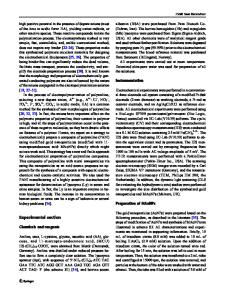Poly(vinyl alcohol)-assisted dispersion of polyaniline nanofiber for electrochemical applications
- PDF / 756,557 Bytes
- 7 Pages / 584.957 x 782.986 pts Page_size
- 71 Downloads / 3,690 Views
Chien-Hsin Yang Department of Chemical and Materials Engineering, National University of Kaohsiung, Kaohsiung 81148, Taiwan
Yen Wei Department of Chemical Engineering, National Cheng Kung University, Tainan 70101, Taiwan; and Department of Chemistry, Tsinghua University, Beijing 100084, People’s Republic of China
Ten-Chin Wena) Department of Chemical Engineering, National Cheng Kung University, Tainan 70101, Taiwan (Received 22 October 2010; accepted 24 October 2011)
Polyaniline nanofiber (PANF) was synthesized using interfacial polymerization and was mixed with aqueous solution of poly(vinyl alcohol) (PVA) to form PANF–PVA binaries. The PANF suspension in water could be stabilized by PVA for more than 3 months due to the hydrogen bonding interaction between PANF and PVA. The specific characteristics of PANF–PVA films was checked by scanning electron microscopy, conductivity measurement, thermogravimetric analysis, Fourier transform infrared spectroscopy, and cyclic voltammetry. The composite film contained 25 wt% PVA (PANF–PVA25) casting at 105 °C was found to have a porous structure and good conductivity. The presence of hydrogen bonding interaction between PANF and PVA improves the electroactivity and electroactive stability of PANF–PVA25 for electrochemical applications. However, an ether linkage between PANF and PVA polymer chain was also found as casting the PANF–PVA film at 200 °C, which is unfavorable for electrochemical applications.
I. INTRODUCTION
Polyaniline (PANI) is unique in the family of conjugated polymers since it has rich redox chemistry and a simple and reversible acid doping/base dedoping process,1 which enables control over properties such as free volume,2 solubility,3 electrical conductivity,4 and chemical/biological sensitivity.5 Nanostructured PANI, especially nanorods, nanowires, and nanofibers, offers the possibility of enhanced performance with a high interfacial area between PANI and its environment. As sensors, these electrically conductive nanostructures have greater sensitivity and faster response time relative to its conventional bulk counterpart due to their higher effective surface areas. However, a simple and effective process for preparing these nanostructures with desired characteristics in their composites remains a scientific challenge, and this is the issue that will be addressed in this article. Generally, the chemical synthesis of PANI uses aniline, an oxidant, and a strong mineral acid dopant.1 PANI nanotubes or nanofibers can be prepared by template-guided polymerization within channels of a)
Address all correspondence to this author. e-mail: [email protected] DOI: 10.1557/jmr.2011.382 2980
J. Mater. Res., Vol. 26, No. 23, Dec 14, 2011
http://journals.cambridge.org
Downloaded: 14 Mar 2015
nanoporous membranes6 or zeolites.6,7 Adding structuredirecting agents, such as a surfactant8 or a comonomer,9 to the chemical polymerization bath is an alternative way to yield PANI nanostructures.8,9 When organic dopants having surfactant functionalities are used, micelle formati
Data Loading...











